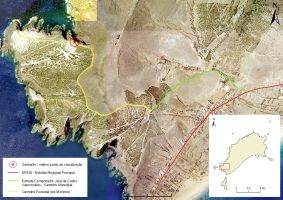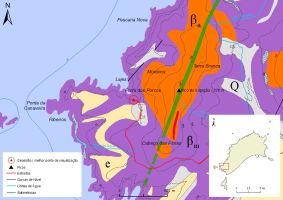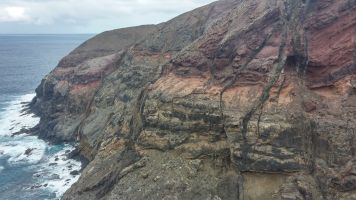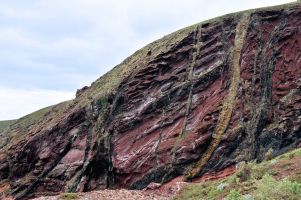 |
Geosite ID: PSt03 Name: Morenos Thematic category: Vulcanology |
 |
Municipality: Porto Santo Civil parish: Porto Santo Location area: 0.1 -10 ha Coordinates(1):33°02'27.00'' N 16°23'17.80'' W Altitude: 104 m Accessibility: Easy Distance to nearest paved road: 6 m Conditions of observation: Good (1) Coordinates of the geosite and / or the best viewpoint |
Brief description
In the coastal cliffs of the Morenos area it is possible to observe a network of volcanic fissural conducts (dykes) of diverse nature, from basaltic to trachytic. These dykes exhibit various stages of magmatic rise related to the different phases of volcanic activity on the island. Some of them present prismatic disjunction. There are also lava flows and hyaloclastites formed undersea, and basaltic subaerial lava flows from the Middle Miocene. This assemblage is covered by much more recent yellowish orange aeolianitic deposits (Quaternary), in which layers of silty-clay brownish paleosols have developed. The presence of root casts in these aeolianites indicates the presence of an ancient vegetation cover, which has developed on these sands around thirty-thousand years ago. Fossils of terrestrial gastropods also occur, many of them representing endemic species already extinct.
Relevant notes
Visiting a site of geological interest is the sole responsibility of the user.
The user must take precautions when visiting the site, taking into account the conditions of the terrain, weather conditions and other hazards, so that they do not create situations that put themselves or others at risk.
The user must respect private property. Access to private areas requires prior authorization from the owners.
The user must respect natural heritage, keeping it intact. The impact of your actions should be minimal.
Protection status
Forest Areas and Natural Areas of Strongly Conditioned Use, in accordance with the Municipal Master Plan.
Bibliography
FERREIRA, M. R. (2014). Património Geológico da Ilha do Porto Santo e Ilhéus Adjacentes (Madeira): Inventariação, Avaliação e Valorização como Contributo para a Geoconservação. Dissertação de Mestrado em Vulcanologia e Riscos Geológicos. Departamento de Geociências da Universidade dos Açores.
RIBEIRO, M. L. Carta Geológica Simplificada das Ilhas da Madeira e do Porto Santo, na escala 1:80.000 in RIBEIRO, M. L. & RAMALHO, M. (2009). Uma visita geológica ao Arquipélago da Madeira, Principais locais Geo-turísticos. Edição da Direção Regional do Comércio, Indústria e Energia e do Laboratório Nacional de Energia e Geologia, I. P, pp. 55, 82. ISBN: 978-989-96202-0-9.
SOARES, A., CALLAPEZ, P. & MARQUES, J. (2006). Aprender em Viagem – Geologia de Porto Santo: notas para uma viagem de estudo. Revista da Associação Portuguesa de Professores de Biologia e Geologia, nº 27, pp. 7-45.
SILVA, J. (2003). Areia de Praia da Ilha do Porto Santo: geologia, génese, dinâmica e propriedades justificativas do seu interesse medicinal. Madeira Rochas – Divulgações Científicas e Culturais, 344 pp.
How to Cite
FERREIRA, M. R. (2014). Património Geológico da Ilha do Porto Santo e Ilhéus Adjacentes (Madeira): Inventariação, Avaliação e Valorização como Contributo para a Geoconservação. Dissertação de Mestrado em Vulcanologia e Riscos Geológicos. Departamento de Geociências da Universidade dos Açores. In: https://geodiversidade.








